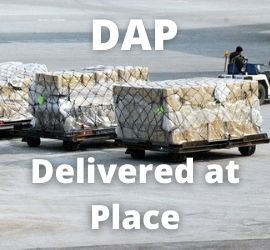What Is Delivered-at-Place (DAP)?
 DAP is an international trade term where the seller is responsible for all costs of shipment from the origin to a specified destination.
DAP is an international trade term where the seller is responsible for all costs of shipment from the origin to a specified destination.
Delivered-at-place is an international logistics term. It describes a deal where a seller agrees to bear all shipping costs and potential losses when moving goods sold to a specific location. In delivered-at-place agreements, the buyer is responsible for paying import duties and any applicable taxes. This includes clearance and local taxes once the shipment has arrived at the specified destination. The term delivered-at-place (DAP) was adopted in the International Chamber of Commerce’s (ICC) eighth publication of its international commercial terms in 2010.
Under DAP Incoterms, the seller is responsible for all risks and costs from the origin to the agreed-upon delivery location. This includes proper packing and all necessary documents. When the shipment reaches the destination specified in the contract of sale, the buyer becomes responsible and assumes all further risks. The buyer is responsible for unloading costs and risks at the named destination as well as any transportation after. Additionally, the buyer is responsible for customs clearance in the importing country. This includes providing import permits, proof of payment, customs taxes, and duties.
When is DAP used?
Delivered-at-place incoterm is applicable for any mode or intermodal transport. It is usually accompanied by the location where the buyer takes responsibility. For example, “DAP, Port of Oakland, Ca.”
DAP – Delivered-at-Place: How it Works
DAP simply specifies that the seller takes on all the risks and costs of delivering goods to an agreed-upon location. This means the seller is responsible for everything related to shipping. This includes packaging, documentation, export approval, loading charges, and ultimate delivery. Conversely, the buyer takes over risk and responsibility beginning with unloading the goods and clearing them for import. A delivered-at-place agreement is applicable for any form, or combination of forms, of transportation. DAP terms usually list the point at which the buyer takes on financial responsibilities. Before 2010, the deal was known as Delivered Duty Unpaid. However, the term was changed in the ICC publication from that date forward. DDU may still be used occasionally, but DAP is the official term used in international trade.
DAP Example
For example, a buyer in San Francisco enters into a DAP deal with a seller from Singapore to purchase a consignment of goods. As a result, the seller from Singapore has to pay to transport the goods from their storage warehouse to the port in Singapore and from that port to San Francisco. If the goods are damaged in any way while they are being transported, the seller will have to bear the cost. Upon the arrival of the goods at the port in San Francisco, the buyer then pays for customs duty, import tariffs, and other local taxes. If the contract mentions the terminal destination as the port in San Francisco, the seller does not have to pay further freight. However, if the terminal destination is the buyer’s warehouse, the seller must pay to move it there as well.
DAP Costs and Responsibilities
International trade deals include several associated costs. This can include things like the cost of obtaining export licenses and related permits, the cost of packaging, the cost of printing product catalogs, etc. The underlying costs may also include dispute settlement. Even though there are clear guidelines for DAP arrangements, a situation resulting in a dispute may still emerge. For example, sometimes, the carrier of the goods may incur what is known as demurrage. This means that they failed to unload the goods on time, owing to a delay in the receipt of proper clearance. Either of the parties could ultimately be at fault.
In such a situation, the fault is attributed to the party that failed to discharge its duty. Providing timely authorization and complete documentation to the goods carrier is a key responsibility. However, determining who is at fault can prove complicated. This is because documentation requirements and definitions may vary from place to place. Documentation requirements are prescribed by national authorities, and these differ from country to country. In many cases, ports within a single country are controlled by different local authorities. This may also give rise to several unanticipated inconsistencies. Some of the basic costs associated with international trade are as follows:
DAP Costs
- Export License Fee – The exporter has to send an application to the controller of imports and exports for an export license. After due examination of the application, the controller issues the license on the payment of a fee.
- Production and Procurement Cost – The exporter has to either produce or procure the goods ordered by the importer. It includes the cost of obtaining and processing raw materials, the cost of labor and machinery, and other related costs.
- Packaging – Packaging cost refers to the cost of protecting the consignment through adequate packaging to ensure minimum damage to the goods during transit. In the absence of proper packaging, the goods stand at a greater risk of damage during transit. The concerned parties must bear any losses arising on this account to the contract.
- Insurance – The goods exported must be protected through insurance so that the concerned parties can recover any loss caused due to damage during transit. The insurance cover is usually taken by whichever party agrees to bear losses caused during transit.
- Freight Charges – Freight includes transporting the goods from the point of production to the assigned air or seaport for shipping and from the latter to the destination port. There are separate freight charges associated with each of them.
- Custom Clearance – When the consignment of goods reaches the port of destination, payments need to be made to unload and transport the goods to the buyer’s warehouse. Moreover, several duties and tariffs must be paid to get permission for letting the goods pass a state or national border. (Source: corporatefinanceinstitute.com)
International Chamber of Commerce Incoterms
The Incoterms are a set of 11 individual rules issued by the International Chamber of Commerce (ICC). For example, DAP is one of seven Incoterms for modes of transport. Incoterms define the responsibilities of sellers and buyers for the sale of goods in international transactions. Incoterm rules clarify the tasks, costs, and risks to be borne by buyers and sellers in international transactions.
Of primary importance is the need for a clear understanding of counter-party responsibilities in international contracts. With the ICC issuing concrete definitions, contracts can refer to the Incoterms. As a result, signing parties have a shared understanding of responsibilities. The Incoterms are updated in order to simplify usages and remove obsolete terms.
Incoterms Clarify Responsibilities
- Invoice and Payment – For example, in each Incoterm rule, a statement is provided as to the seller’s responsibility to provide the goods and commercial invoice in conformity with the contract of sale. Likewise, a corresponding statement is provided which stipulates that the buyer pays the price of goods as provided in the contract of sale.
- Import and Export Authorization – Each Incoterm rule has a statement stipulating which party is responsible for obtaining any export license or other official authorization required for export and for carrying out the customs formalities necessary for the export to proceed. Similarly, each rule has a corresponding statement as to which party is responsible for obtaining any import license or other official authorization required for import and for carrying out the customs formalities required for the import of goods. These statements also specify which party bears the cost of handling these tasks.
- Carriage, Insurance, Packing & Inspections – Similarly, each Incoterm rule specifies which party to the transaction, if any, is obligated to contract for the carriage of the goods. Another point addressed in each Incoterm rule is which party, if any, is obligated, to provide for cargo insurance coverage. These statements also specify which party bears the cost of handling these tasks. Each rule also contains statements, among others, as to which party is responsible for packing the goods for transport overseas and for bearing the costs of any pre-shipment inspections.
- Cargo Delivery – Each Incoterm rule specifies the seller’s obligations for cargo delivery and clarifies when delivery takes place. Each rule also specifies when the risk of loss or damage to the goods being exported passes from the seller to the buyer by reference to the delivery provider. (Source: trade.gov)
Up Next: TERP – What Is the Theoretical Ex-rights Price?
 TERP is the Theoretical Ex-rights Price of a company’s shares following a rights issue. It is usually calculated as the weighted average price of the combined existing and new company shares. A rights issue happens when a company issues new shares for cash to the current shareholders. Rights shares are issued at a price slightly below the market price of the company’s prevailing shares. This is done to encourage the existing shareholders to purchase the shares while generating cash for the company.
TERP is the Theoretical Ex-rights Price of a company’s shares following a rights issue. It is usually calculated as the weighted average price of the combined existing and new company shares. A rights issue happens when a company issues new shares for cash to the current shareholders. Rights shares are issued at a price slightly below the market price of the company’s prevailing shares. This is done to encourage the existing shareholders to purchase the shares while generating cash for the company.
As a result, TERP is the estimated market price that a stock will theoretically have following the new rights issue. Companies sometimes issue new rights shares to existing shareholders as a benefit and to generate cash. Ultimately, stock prices are affected by a new rights issue because it increases the number of shares outstanding. Because the shares are offered at a discount, this will usually lower the overall share price to some extent.




